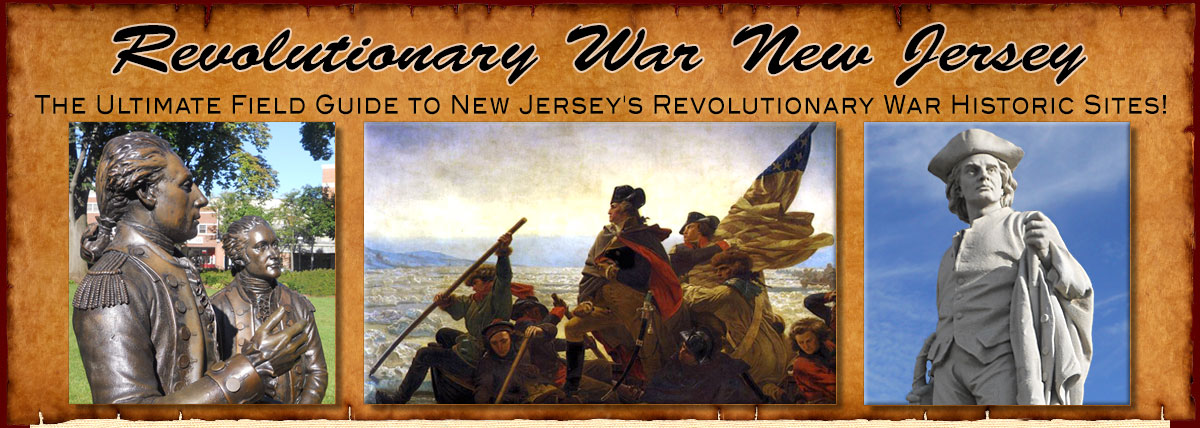

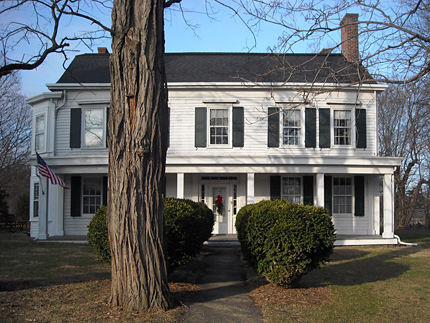
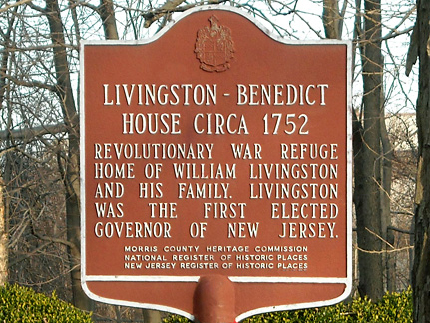
Livingston-Benedict House
25 Old Parsippany Rd.
Map / Directions to Livingston-Benedict House
Map / Directions to all Parsippany Revolutionary War Sites
This house is a private residence.
Please respect the privacy and property of the owners.
William Livingston (November 30, 1723 – July 25, 1790) played several important roles in the Revolutionary War era, both political and military. He served in the Continental Congress from 1774 - 1776. He was commissioned a brigadier general in the New Jersey Militia. Then in August 1776, less than two months after American Independence was declared, he became the first elected governor of New Jersey. Prior to American Independence, New Jersey was still a British colony and had a Royal Governor appointed by the King of England. New Jersey's last Royal Governor had been William Franklin, the son of Benjamin Franklin. Livingston was repeatedly reelected governor, and remained in office until his death in 1790. In 1787, while still governor, he attended the Constitutional Convention. He was one of four signers of the Constitution for New Jersey. The other three New Jersey signers were:
• David Brearly (Buried at St. Michael's Episcopal Church in Trenton)
• Jonathan Dayton (Lived at Boxwood Hall in Elizabeth, and buried at St. John's Episcopal Cemetery in Elizabeth)
• William Paterson (Paterson is named in his honor)
Governor Livingston's main residence was Liberty Hall in a part of Elizabeth which is now the township of Union. During the Revolutionary War, he leased this house (built circa 1752), and he lived in it at times when British troop locations made Liberty Hall unsafe. However, Livingston was not free from danger in Parsippany either; the The New Jersey Gazette printed a piece in its July 28, 1779 edition about an attempted attack on this house, which included the following:
(The misspellings of Parsippany, conspiracy, conspirators and patrols are from the original newspaper article, and have been left uncorrected.
"22 ult." means on the 22nd of the previous month, which in this case would have been June 22. Gaol is an archaic spelling of jail. )
"A number of villains (says a correspondent) in the vicinity of Persippeney, Morris county, having for some days before been suspected of being concerned in a conspiricy to take or assassinate Governor Livingston, as soon as he should return from the General Assembly; a son of the Governor's having previously induced one of the persons suspected to believe that His Excellency was looked for on the 22 ult. caused a report to be propagated towards the evening of that day, that he was actually returned. As the young Gentleman suspected that the conspiritors would, in consequence of the report, attack the house that night, he had concerted proper measures for their reception. Accordingly, at about two o'clock the next morning the ruffians were discovered within 50 yards of the Governor's house; but being fired upon by one of our patroles, they instantly took into the woods and fled. The person however, who was suspected to be at the head of the gang, and who had for some time past taken up his residence in that neighbourhood to facilitate the conspiricy, disappeared the next morning, was pursued and taken. He is committed to gaol in Morris-town and has already made considerable discoveries." [1]
The house is known as the Livingston-Benedict House. The Benedict part of the name comes from Farrand N. Benedict, who purchased the house in 1857. Descendents of Benedict have lived in this house since then, right up to the present. Although the house is a private residence, the current owners occasionally hold open houses. [2]
The Livingston-Benedict House is located on Old Parsippany Road, a small dead end off the main Parsippany Road. On the corner before you turn in, you will see a small park named for Governor Livingston.

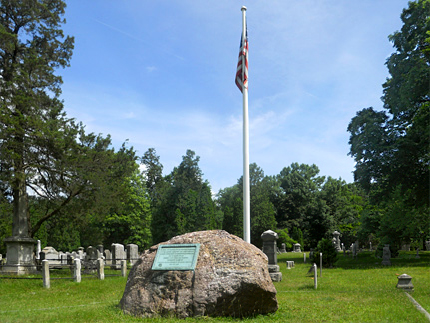
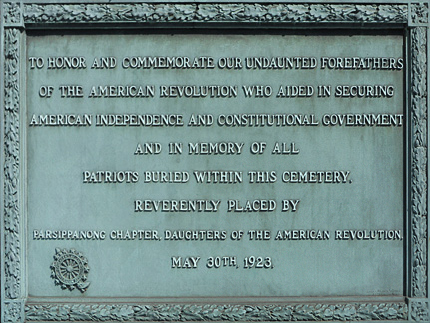
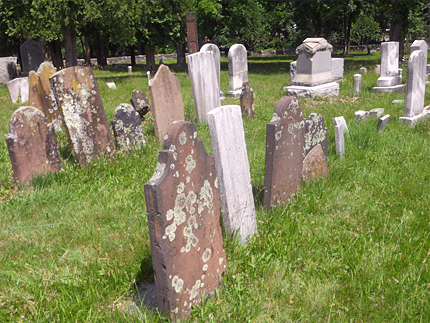
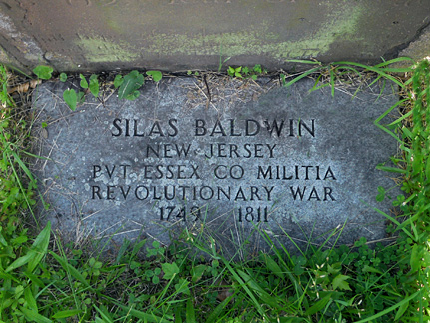
Vail Memorial Cemetery
Rt. 46. West
Map / Directions to Vail Memorial Cemetery
Map / Directions to all Parsippany Revolutionary War Sites
Vail Memorial Cemetery contains the graves of Revolutionary War soldiers, including: [3]
Lewis Baker
1751-1830
Private, NJ Militia
Silas Baldwin
1749 - 1811
Private, Essex County Militia
Thomas Cobb
1760 - 1845
Sgt., 3rd NJ Regiment
(Also served in the War of 1812)
Thomas Compton
Died Feb 27, 1797
Private, Eastern Regiment, NJ Militia
Bethuel Farrand
October 4, 1741 - May 27, 1794
2nd Lieutenant, Captain Seeley's Company
Daniel Farrand
January 19, 1764 - February 16. 1829
Private, Morris County NJ Militia
(Also served in the War of 1812)
Phineas Farrand
1746 -1822
Captain Miner's Company, Eastern Battalion
Samuel Farrand
1757 - 1788
Private, Morris County NJ Militia
Jonathan Grimes
1736 - 1815
Private, Morris County NJ Militia
John Hayward
1749 - 1808
Private, Morris County NJ Militia
Benjamin Howell
October 10, 1725 - December 26, 1798
Not a soldier,
but served on the Committee of Observation
His house is in Parsippany (See next entry)
Jeremiah Howell
September 25, 1747 - February 17, 1846
Sgt, NJ Militia
Edward Paddleford
1740 - 1813
Jasper Righter
1739 - 1794
Private, Morris County Militia
Jonathan Stiles
1753 -1830
Assistant Quarter Master, Morris County Militia
John Stiles
New Jersey - Paymaster - Commissary of Issues
1779
- 1777
Abraham Kitchel (Died January 11, 1807, age 71), who served in the Provincial Congress of New Jersey, is most likely also buried in this cemetery. However, his gravestone no longer exists. For more information about Abraham Kitchel, see the entry for his house on the Denville page.[4]

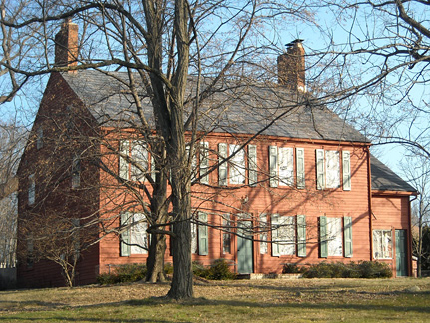
Benjamin Howell House
709 S. Beverwyck Rd.
Map / Directions to the Benjamin Howell House
Map / Directions to all Parsippany Revolutionary War Sites
This house is a private residence.
Please respect the privacy and property of the owners.
Born in Southampton, Long Island in 1925, Benjamin Howell came to New Jersey around 1749. He built this house in 1763 and later enlarged it to its present appearance in 1793. [5]
Howell was politically active for the American cause during the Revolutionary War. In 1775 he was named to a Committee of Observation for the Township of Hanover. [6] (What is now Parsippany-Troy Hills was then part of Hanover Township.) [7] He was elected a Morris County Justice of the Peace in 1776 and re-elected to another five year term in 1781. He therefore served in that position throughout the Revolutionary War. [8] He died in 1798, and is buried in Vail Memorial Cemetery (See above entry)
The house may have been used for military conferences during the winter of 1779-1780, while Washington's army was encamped at Morristown. [9]

1. ^ The New Jersey Gazette, Vol. II., No. 83, July 28, 1779, as reprinted in:
William Nelson, Editor, Archives of the State of New Jersey. Second Series. Volume III (Trenton: The John L. Murphy Publishing Company, 1906) Pages 515-516
Available to be read at the Internet Archive here2. ^ Peterson, Julia. “Gov. Livingston Slept Here—And Now, I Do.” Patch.com. Parsippany, NJ. Apr 9, 2011. https://patch.com/new-jersey/parsippany/gov-livingston-slept-here-and-now-i-do
3. ^ Gravestones and markers in the cemetery
Note that Thomas Compton's grave is marked by his original stone, and a modern Revolutionary War soldier Marker. These two markers have contradictory date information. The original stone states "In Memory of Thomas Compton who died Feb. 27, 1797 in the 57th year of his age." The modern marker states that he was born in 1725, and died in 1797. Because of this confusion about when he was born, the main entry above only states "Died Feb 27, 1797."4. ^ CEMETERY RECORDS OF MORRIS COUNTY, NEW JERSEY PARSIPPANONG CHAPTER, N. S. D. A. R. - (Posted by Brianne Kelly-Bly, the volunteer county coordinator for the NJGenWeb Morris County website here)
This record of grave tombstone inscriptions made in 1938 lists "Abraham Kitchell Esq. Died Jan 11, 1807. Age 71 yrs." with a note about the state of the tombstone at that time, "brown stone good." The tombstone apparently no longer exists.
The date of death matches the listing for Abraham in the Daughters of the American Revolution Genealogical Research System, where he is Ancestor # A065759, so this was most likely the same person.5. ^ Catherine S. Howell, "The Howell Homestead of Troy Hills" Proceedings of the New Jersey Historical Society Vol VI, No. 3 July 1921. Available to be read at the Internet Archive here
and
National Register of Historic Places Inventory -- Nomination Form submitted for the Benjamin Howell House to the United States Department of the Interior National Park Service, received May 17, 1978. Available as a PDF on the National Park Service website hereEdmund D. Halsey and others, History of Morris County, New Jersey with Illustrations and Biographical Sketches of Prominent Citizens and Pioneers. (New York: W. W. Munsell & Co. 1882) Page 25
Available to be read at the Internet Archive here6. ^The minutes for the February 15, 1775 meeting of the Committee of Observation of the Township of Hanover list Howell as attending:
Minutes of the Provincial Congress and the Council of Safety of the State of New Jersey (Trenton: Naar, Day & Naar, 1879) p. 52 - 54)
Available to be read at the Internet Archive Here7. ^ At a special election in Hanover Township on May 9, 1928, "An Act to incorporate the township of Parsippany-Troy Hills, in the county of Morris" was adopted. Recorded in:
Acts of the One Hundred and Fifty-Second Legislature of the State of New Jersey 1928 (Trenton: MacCrellish & Quigley Co, 1928) Page 893
8. ^ Edmund D. Halsey and others, History of Morris County, New Jersey with Illustrations and Biographical Sketches of Prominent Citizens and Pioneers (New York: W. W. Munsell & Co. 1882) Page 76
Available to be read at the Internet Archive here9. ^ The National Register of Historic Places Inventory -- Nomination Form for the Benjamin Howell house states that "the farmstead was an important site for Washington's military conferences during the winter of 1779-1780 while encamped at Morristown." This information also appears in other non-primary sources. However, I did not find any documentation for this, and I am a bit skeptical of the claim.
When Catherine S. Howell wrote the article "The Howell Homestead of Troy Hills" in 1928, she made no mention of Washington having been at the house. She does mention that a number of Howells served as soldiers and officers in the Revolutionary War, and Benjamin Howell "serving as Justice of the Peace and filling other positions of trust." With this in mind, it seems odd that she would not mention that George Washington held military conferences in the house if she had any knowledge of it. If she had ever heard of the story, she almost certainly would have included it in what is a history of her own family. She also mentions that the Howell family was still living in the house at the time she wrote the article. If Washington had been in the house, it seems likely that the story would have stayed within the family from generation to generation, and so she would almost certainly heard the story, or at least come across it while researching the family history for the article.
For these reasons, the main entry above states that the house may have been used for military conferences.